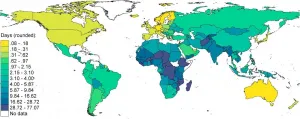(Press-News.org) When scientists at the Institute of Science and Technology (IST) Austria looked at developing zebrafish embryos, they observed an abrupt and dramatic change: within just a few minutes, the solid-like embryonic tissue becomes fluid-like. What could cause this change and, what is its role in the further development of the embryo? In a multidisciplinary study published in the journal Cell, they found answers that could change how we look at key processes in development and disease, such as tumor metastasis.
To learn more about how a tiny bunch of cells develops into complex systems like fish, humans or animals as big as elephants, many scientists turn to the zebrafish (Danio rerio). It has a few advantages that made it one of the favorite model organisms of developmental biologists like Nicoletta Petridou, until recently postdoc at the research group of Carl-Philipp Heisenberg at the Institute of Science and Technology (IST) Austria. First, the small striped fish develop within just a few days, the embryos do so outside their mothers and are transparent - one can see every organ as it develops. While looking at zebrafish embryos a few hours after fertilization, in a previous study Nicoletta Petridou and her colleagues discovered a sudden change in the viscosity of the embryonic tissue - a measure of a tissue's resistance to deformation: "At this early stage, the tissues forming the embryo are very rigid, but suddenly, viscosity drops by ten times and the tissue flows very quickly - it fluidizes," the biologist explains.
Small change - big effect
Simultaneously, the embryo starts changing its shape for the first time, thereby entering a phase called morphogenesis. In a new study, the researchers looked deeper into what is happening at the cellular level during tissue fluidization. "What we found was that before this fluidization, an individual cell is connected to four to five of its neighboring cells. At the onset of fluidization, however, it has only three to four neighbor connections left," says Petridou. Could this small change in the cells' connectivity really be responsible for a ten-fold difference in the tissue viscosity? "This was when we turned to physics to provide us with a framework that could explain this effect," says the molecular and developmental biologist.
"So, Nicoletta found this massive drop in tissue viscosity at the macroscopic level that is apparently not matching what is going on at the microscopic cell connectivity level. This is a key point of physics: to link what is going on at the microscopic level with the macroscopic level," says Bernat Corominas-Murtra, until recently part of Edouard Hannezo's research group. Using an analogy with material science, the team realized that each cell having four connected neighbors was actually a very special threshold: physicist James Clerk Maxwell in the 19th century had already realized that structures such as bridges or networks below this connectivity level cannot be rigid anymore. This precisely matched the experimental observations of tissue fluidization occurring when cells are connected to less than four neighbors. Using this analogy, the team was able to show that the fluidization of the tissue displays features of a phase transition, which is the transition from one state of matter like solid, liquid or gas to another.
A critical point
After finding this resemblance to phase transitions, the scientists challenged their theory by manipulating the cells' connectivity. No matter the manipulation, the critical point of connectivity was enough to explain the abrupt changes in tissue viscosity experimentally observed. Furthermore, they traced all expected features of phase transitions from the physics of non-living systems. "It is unique to be able to trace all the expected properties of a phase transition in a real, living system. Especially because the phase transition theory is made for systems with a billion components, whereas, here we are talking about a system with a few hundred components," Corominas-Murtra explains enthusiastically.
But, if the loss of only one connection per cell is enough to trigger such a significant change of the embryo's tissue, how can an accidental change be avoided? "What was very puzzling for me was that it seems to be a very risky process for the embryo. Now that we know there is a critical point, we can ask what regulates its balance. One of the regulations we found is the timing of cell divisions that defines how tissue connectivity, and thus its viscosity, changes in space and time," says Petridou, who has just started her own research group at the European Molecular Biology Laboratory (EMBL) in Heidelberg, Germany.
From fish embryos to tumor research
The transition is essential for the further development of the tiny fish embryo. However, it also seems to play a role in cancer growth. When a tumor metastasizes, recent studies have shown the tissue also abruptly changes from solid to liquid, which could allow cancer cells to move around more easily. "If one can trace this critical point, it opens ways to manipulate it," says Petridou. "We don't have the tools yet to do so, but instead of conceptually focusing on the large number of genes that could play a role in cancer growth, one could focus on this critical point that eventually causes this transition."
Working together with researchers from two different research groups at IST Austria proved essential for the scientists' success. "I remember spending hours in the lab with Nicoletta trying to figure out what she was doing and the other way around. We needed to reach a common language, which takes a lot of time but is very rewarding. Multidisciplinarity is an attitude," says Bernat Corominas-Murtra, who has recently started working as an assistant professor at the Austrian Karl-Franzens University Graz.
INFORMATION:
Publication:
Nicoletta I Petridou, Bernat Corominas-Murtra, Carl-Philipp Heisenberg & Edouard Hannezo. Jahr. Rigidity percolation uncovers the structural basis of embryonic tissue phase transitions. Cell. https://doi.org/10.1016/j.cell.2021.02.017
Funding information:
The IST Austria project part was supported by funding from the Elise Richter Program of the Austrian Science Fund (FWF) to Nicoletta Petridou (V 736-B26), the European Research Council Advanced grant (742573) to Carl-Philipp Heisenberg, and the European Research Council Starting grant (851288) to Edouard Hannezo.
CAMBRIDGE, MA -- In the past few years, several medications have been found to be contaminated with NDMA, a probable carcinogen. This chemical, which has also been found at Superfund sites and in some cases has spread to drinking water supplies, causes DNA damage that can lead to cancer.
MIT researchers have now discovered a mechanism that helps explain whether this damage will lead to cancer in mice: The key is the way cellular DNA repair systems respond. The team found that too little activity of one enzyme necessary for DNA repair leads to much higher cancer rates, while too much activity can produce tissue damage, especially in the liver, which can be fatal.
Activity ...
Several oceans' worth of ancient water may reside in minerals buried below Mars' surface, report researchers. The new study, based on observational data and modeling, shows that much of the red planet's initial water - up to 99% - was lost to irreversible crustal hydration, not escape to space. The findings help resolve the apparent contradictions between predicted atmospheric loss rates, the deuterium to hydrogen ratio (D/H) of present-day Mars and the geological estimates of how much water once covered the Martian surface. Ancient Mars was a wet planet - dry riverbeds and relic shorelines record a time when vast volumes of liquid water flowed across the surface. Today, ...
Birds breathe with greater efficiency than humans due to the structure of their lungs--looped airways that facilitate air flows that go in one direction--a team of researchers has found through a series of lab experiments and simulations.
The findings will appear Fri., March 19 in the journal Physical Review Letters (to be posted between 10 and 11 a.m. EDT).
The study, conducted by researchers at New York University and the New Jersey Institute of Technology, also points to smarter ways to pump fluids and control flows in applications such as respiratory ventilators.
"Unlike the air flows deep in the branches of our lungs, which oscillate back and forth as we breathe in and out, the flow moves in a single direction in ...
PHILADELPHIA - Imposter syndrome is a considerable mental health challenge to many throughout higher education. It is often associated with depression, anxiety, low self-esteem and self-sabotage and other traits. Researchers at the Sidney Kimmel Medical College at Thomas Jefferson University wanted to learn to what extent incoming medical students displayed characteristics of imposter syndrome, and found that up to 87% of an incoming class reported a high or very high degree of imposter syndrome.
"Distress and mental health needs are critical issues among medical ...
PITTSBURGH (March 16, 2021) ... During the swarming of birds or fish, each entity coordinates its location relative to the others, so that the swarm moves as one larger, coherent unit. Fireflies on the other hand coordinate their temporal behavior: within a group, they eventually all flash on and off at the same time and thus act as synchronized oscillators.
Few entities, however, coordinate both their spatial movements and inherent time clocks; the limited examples are termed "swarmalators"1, which simultaneously swarm in space and oscillate in time. Japanese tree frogs are exemplar swarmalators: each frog changes both its location and rate of croaking ...
How much do people have to pay for a travel permit to another country? A research team from Göttingen, Paris, Pisa and Florence has investigated the costs around the world. What they found revealed a picture of great inequality. People from poorer countries often pay many times what Europeans would pay. The results have been published in the journal Political Geography.
Dr Emanuel Deutschmann from the Institute of Sociology at the University of Göttingen, together with Professor Ettore Recchi, Dr Lorenzo Gabrielli and Nodira Kholmatova (from Sciences Po Paris, CNR-ISTI Pisa and EUI Florence respectively) compiled a new dataset on visa costs for travel between countries worldwide. The analysis shows that on average people ...
COLUMBUS, Ohio - The link between psychological stress and physical health problems generally relates to a stress-induced immune response gone wild, with inflammation then causing damage to other systems in the body. It's a predictable cascade - except in pregnancy, research suggests.
Scientists exploring the negative effects of prenatal stress on offspring mental health set out to find the immune cells and microbes in stressed pregnant mice most likely to trigger inflammation in the fetal brain - the source for anxiety and other psychological problems identified in previous research.
Instead, the researchers found two simultaneous conditions ...
Wearable electronic devices like fitness trackers and biosensors, are very promising for healthcare applications and research. They can be used to measure relevant biosignals in real-time and send gathered data wirelessly, opening up new ways to study how our bodies react to different types of activities and exercise. However, most body-worn devices face a common enemy: heat.
Heat can accumulate in wearable devices owing to various reasons. Operation in close contact with the user's skin is one of them; this heat is said to come from internal sources. Conversely, when a device is worn outdoors, sunlight acts as a massive external source of heat. These sources combined can easily raise the temperature ...
The vast majority of people infected with SARS-CoV-2 clear the virus, but those with compromised immunity--such as individuals receiving immune-suppressive drugs for autoimmune diseases--can become chronically infected. As a result, their weakened immune defenses continue to attack the virus without being able to eradicate it fully.
This physiological tug-of-war between human host and pathogen offers a valuable opportunity to understand how SARS-CoV-2 can survive under immune pressure and adapt to it.
Now, a new study led by Harvard Medical School scientists offers a look into this interplay, shedding light on the ways in which ...
A Florida State University professor's research could help quantum computing fulfill its promise as a powerful computational tool.
William Oates, the Cummins Inc. Professor in Mechanical Engineering and chair of the Department of Mechanical Engineering at the FAMU-FSU College of Engineering, and postdoctoral researcher Guanglei Xu found a way to automatically infer parameters used in an important quantum Boltzmann machine algorithm for machine learning applications.
Their findings were published in Scientific Reports.
The work could help build artificial neural networks ...


